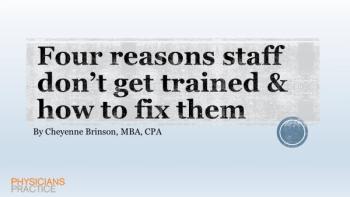
Getting your patients to take the first step towards better health can be a struggle. Here is a simple reframing technique that could help.

Getting your patients to take the first step towards better health can be a struggle. Here is a simple reframing technique that could help.

Reflect on what requests you want to accept before obediently saying yes, especially those that detract from your career goals.

A high-performing website can help further your brand, serve as a useful resource and showcase pleased patients.

Short-staffed practices need to have a plan in place when they lose a doctor to preserve the practice operations and patient care.

Patient grievances about their visits to medical practices can be sorted into three categories that require action by all employees.

Imagine: the freedom to care for patients the way you want to, not the way insurance mandates or regulations require.

Seven ways to adapt to new regulations coming from D.C. while still managing to treat patients.

How to recognize-and overcome-the common thought process of overconfidence when it comes to practicing medicine.

While human contact is natural and banter is commonplace, be mindful of how words and actions are received by those with different perceptions.

Staff training is essential to running a successful practice. Here are four reasons why it often gets overlooked and how to change that.

A Lean Six Sigma concept can help medical practices boost patient satisfaction and experience by simply looking at who does the tasks required.

"Leading by examples" means giving our team clear direction on what great care is. Here’s how to start.

Tech and staffing are two ways that your practice can reduce burnout for physicians and other stressed out employees.

What is time-driven activity based cost accounting and how does it help your practice understand the cost of seeing a patient?

People don't like being told what to do - they prefer to be encouraged to think through how to best manage a situation.

Look at the easy stuff to reduce the cost of overhead at your practice and go from there. There's a lot of money to be saved.

Are you issuing embarrassing correction emails after goofing up your initial correspondence? Here's how to avoid this snafu.

With more patients likely to be uninsured due to the individual mandate repeal, here are creative ways of providing cost effective primary care.

Here is how you can give your practice staff constructive feedback, helping them build on strengths and discover ways to improve.

When it comes to designing your practice, be sure to design with the patient, and then the doctor, in mind.

Here are nine things you can be doing to ensure that your practice is putting its patients first.

If you're nervous about giving a presentation to staff, colleagues, patients, or to the public, here are a few things to know.

Here are five tactics to reduce many of the more common risks of data loss at your practice. Make sure you're up to date.

Strategically planning IT investment and implementation is important for any small-to-mid-sized practice.

There are significant decisions a physician must make when setting up a DPC practice. Here are a few you must decide.

What do practices need to know about coding for advance care planning? Here is some guidance from the AAPC's John Verhovshek.

Patients are becoming more and more interested in getting cared for by their provider at home, whether through tech or otherwise.

It's easy to check references, verify clinical skills and training, and see if a physician is in your price range. Cultural fit is harder to ascertain.

Use Excel Pivot Tables and Microsoft SQL Server to enhance the way your practice creates reports from its PM and EHR systems.

Patients want in-demand service. Here are a few ways to provide that to them at your practice.